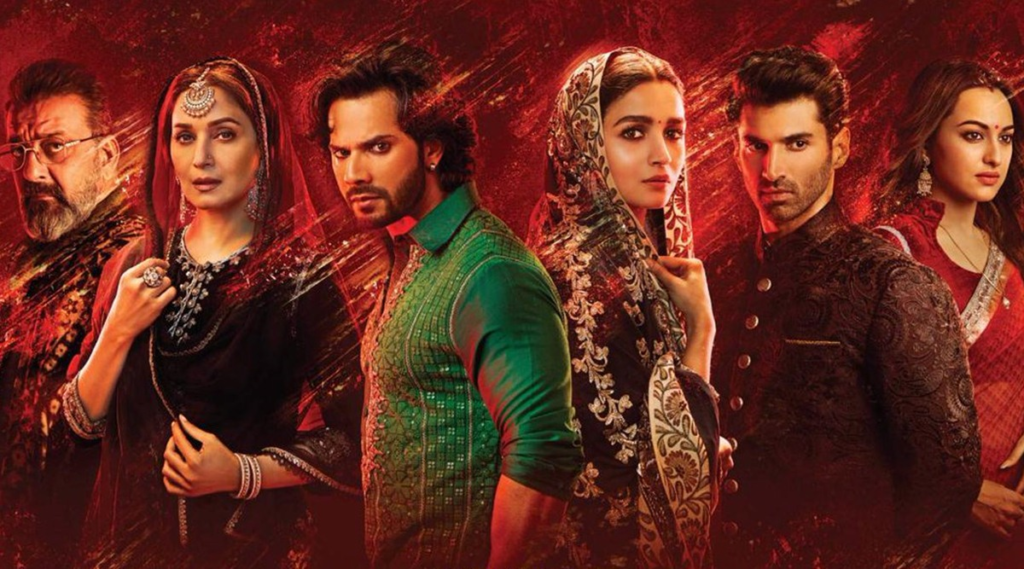Imagine a movie, which has the potential to strike a chord with the audiences after movies based on partition like Gadar, Train to Pakistan, Pinjar, to name a few, mesmerized the audiences with the same. You have some of the most influential stars to play the important roles. You have the backing of Dharma Productions. Nothing can go wrong here, right? That’s where the audience gets duped by Abhishek Varman’s ‘Kalank’, which like ‘Zero’, truly justifies the movie title – it is indeed a ‘Kalank’ [blot] on the face of Indian cinema.
Plot –
Satya Chaudhary [Sonakshi Sinha] is informed that she would succumb soon to the cancer that she got diagnosed with. In order to give her loving husband Dev [Aaditya Roy Kapur] another shot at a better life, she surprisingly arranges his marriage with an acquaintance’s rebellious daughter Roop [Alia Bhatt].
Unable to adjust to the rigors of the Chaudhary household, Roop finds solace in learning music from an ex-courtesan Baahar Begum [Madhuri Dixit], who resides in the notorious Heera Mandi of Husnabad, a majestic city near Lahore, British India. How her adulterous relationship with the local womanizer Zafar [Varun Dhawan] affects the Chaudhary household, as well as her own life, especially in the wake of the partition, forms the crux of the story.
The Bad –
Usually, some movies become case studies for aspiring filmmakers as to how to create such compelling masterpieces. However, in the case of Kalank, it is the complete opposite. If this movie were a case study, it would’ve been a perfect case study on how not to make a period drama.
Zero originality, plagiarizing from various sources, including lifting a plot line from Munshi Premchand’s ‘Saut’ (observe the angle between Satya, Roop and Dev), and mediocre storytelling makes Kalank an unforgettable drag. The movie copied blatantly from Bahubali, Gadar, Padmaavat, DDLJ etc, failing to infuse the magic of either.
The editor of this movie needs some serious lessons in basic film editing. For a movie like Kalank, it was almost hilarious to see English subtitles being inserted and faded at whim. For the VFX of the movie, the lesser said, the better.
The movie is so bad, that even films like ‘Thugs of Hindostan’ and ‘Zero’ would look handsome in front of this. If the producers are brave enough to pump in 80 crores for this period drama, could they not spend some money for a decent script? Despite having a plotline with some potential, the characters of Sanjay Dutt and Madhuri Dixit were extremely underutilized.
The Ugly –
If Kalank was just bad cinema, one wouldn’t have felt so disgusted. It is the propaganda that was infused in this movie that makes it worse. For starters, why is it such a matter of prestige, that there must be a Muslim protagonist with a golden heart? Would it have cost the makers of Kalank too much had Varun Dhawan been portrayed as a respectable and devout Hindu student, or a Sikh? Despite the movie being set in British India of 1940s, there was negligible mention of Sikh characters. Also, how is involving oneself in an adulterous relationship a sign of progressiveness? If there is one thing this movie cannot be forgiven at all for, it is shamelessly glorifying adultery.
The Hinduphobia of elite Bollywood was also at display in this movie. The Muslims are portrayed as the rebellious majority who’re oppressed by the intolerant ‘Hindu’ minority. This is quite evident from the scene where a Munshi, portrayed by Deepak Qazir Kejriwal, is extremely intolerant towards Zafar and his community of blacksmiths. While some of the movie buffs have accused this movie of promoting the vicious practice of love jihad, its depiction in Kalank is so amateurish that you’d find it rather hilarious than annoying.
Most of the Hindu characters, with the sole exception of Dev, are shown as greedy, promiscuous, and intolerant towards the other communities. Though the propaganda is not as horrifying as ‘Kedarnath’, it is not worth ignoring either. The movie also attempted to justify the horrendous tragedy of partition as the inevitable result of a class struggle between the ‘Hindu capitalists’ and the oppressed ‘Muslim working class’.
Wasn’t this the same disgusting approach used by Barkha Dutt for justifying the genocide of the Kashmiri Pandits? It looks as if Abhishek Varman had taken a lesson or two from this journalist in terms of peddling propaganda through Kalank. If history, common sense, geography and logic were people, they would’ve and should’ve rightfully sued the director, as well as the producers for molesting them with this disaster of a movie called Kalank.
Is there anything even Good?
However, even in the dark clouds, there is a ray of sunshine. The few bright spots in this movie were the music, the sets, and actors Aditya Roy Kapur and Alia Bhatt. For a person, who has been way too much underutilized in other movies, Aditya Roy Kapur surprises one and all as the no nonsense manager of Daily Times, Dev Chaudhary.
A true-blue progressive, who doesn’t like being bullied by political compulsions, a better focus on Dev’s personality would’ve removed the scourge of watching a movie laden with Kalank. Though Alia Bhatt’s Roop makes us frown with her constant confusion and her dumb approach to human relationships, in terms of acting, she essays her role quite well.
Had the character of Varun Dhawan not been exploited for the propaganda of the makers, he did nail the role effortlessly. Even Kunal Khemmu, as the vicious fanatic Abdul, surprises us with the conviction to his role. We wish he gets better opportunities.
All in all, Kalank was a golden opportunity to depict the complexities of relationships in the wake of the partition that got subdued by propaganda. Grand sets and foot tapping music aren’t enough to make a movie a success, if the content is mediocre. We’d rate Kalank with 1/5 stars.
